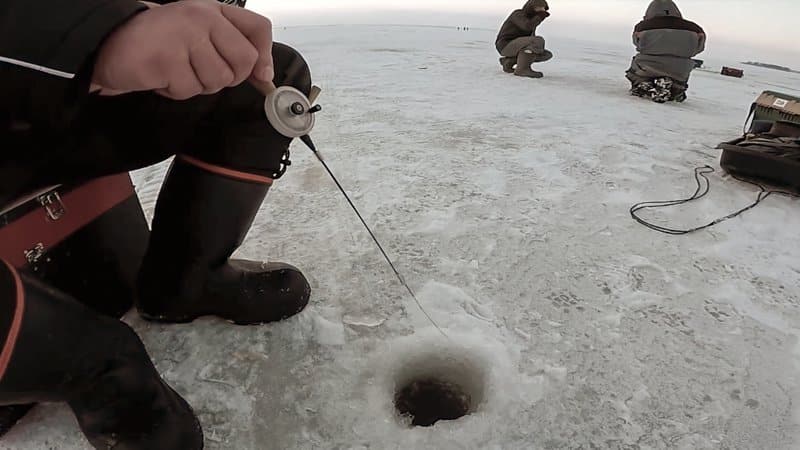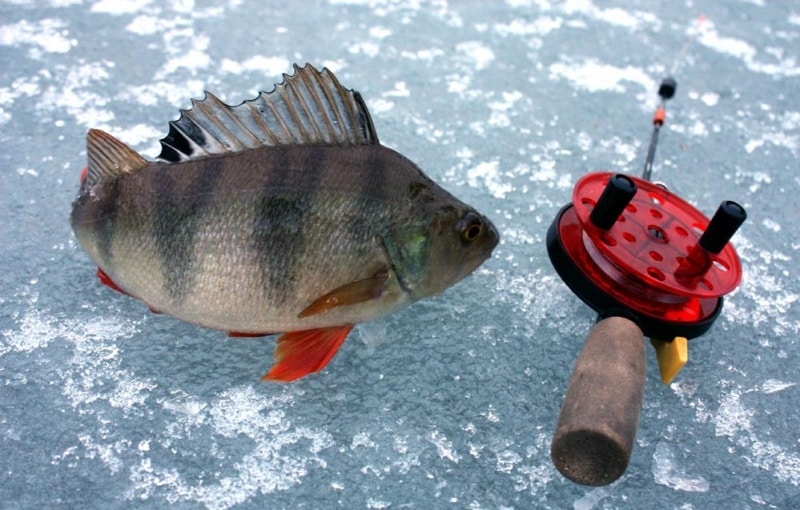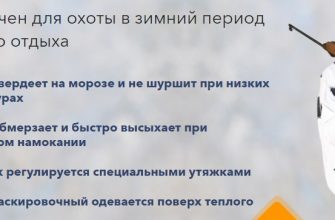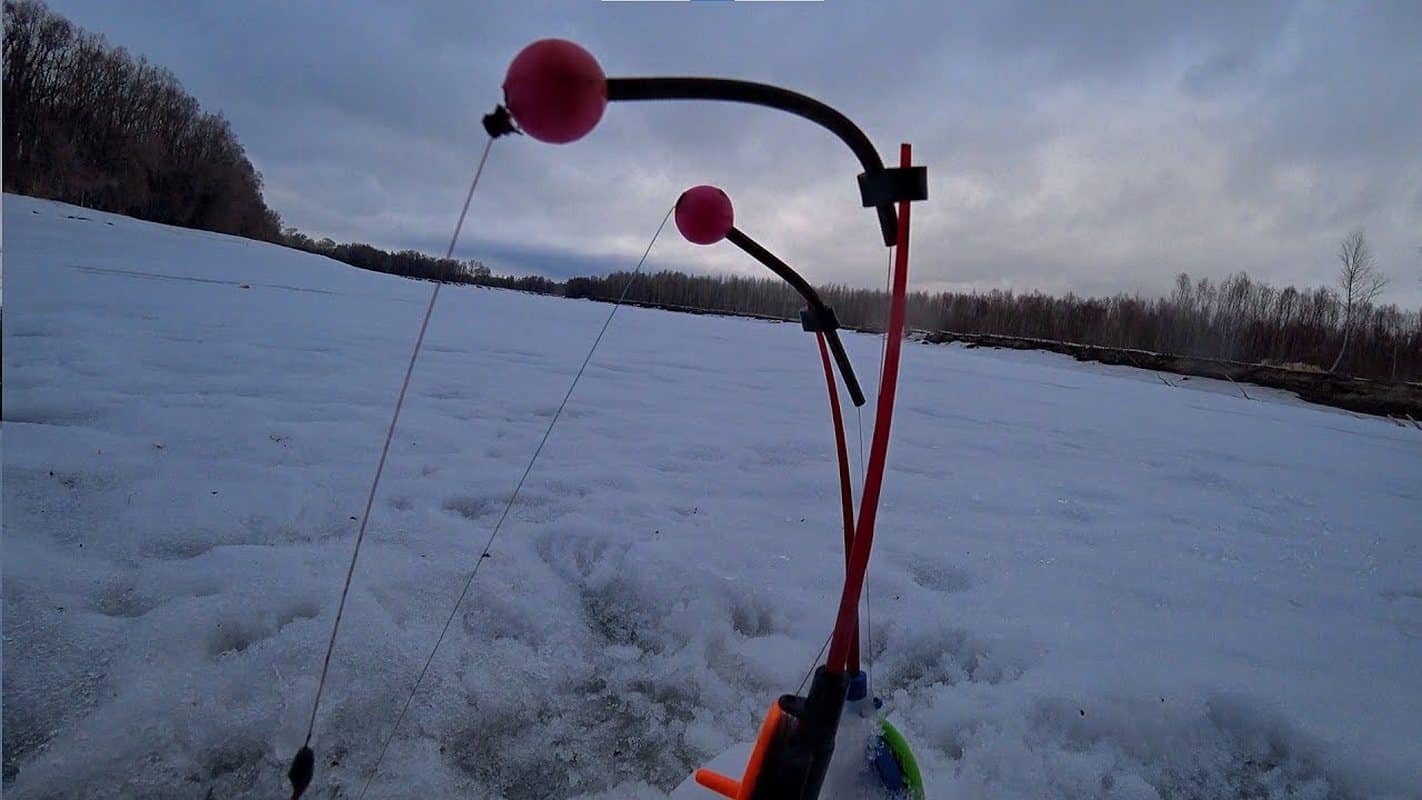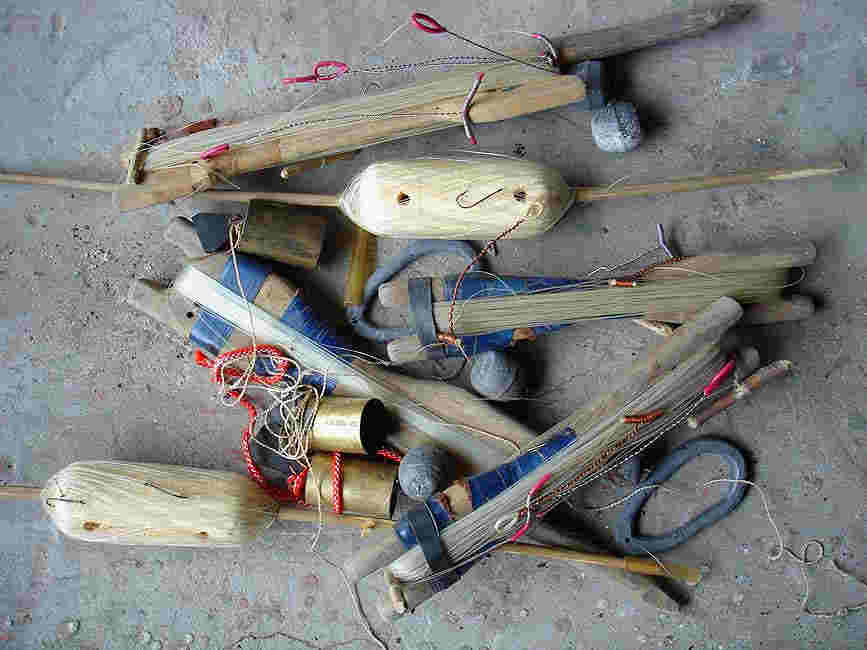Ice fishing is associated with perch fishing for most winter anglers. It is this fish that most often occurs both in the main catch and in the by-catch among other fish in hard water.
- What you need to know for winter percolators: the basics
- When to go fishing
- Winter fishing for perch: search and fishing tactics
- First ice
- Even before the deafness
- What to do if the reservoir is large – the tactics of catching large perch in wide waters
- Deafness – a period of passivity
- On a pond in late winter – early spring
- What can you catch perch in in winter – popular fishing methods and winter lures
- Fishing for perch with balance weights
- Flashing
- Catching on reels: devil, jellyfish, goat, bulldozer and others
- Fishing for large perch in winter – important to know
- Top dressing
- Winter tackle for perch – what to look for?
- Поделиться ссылкой:
What you need to know for winter percolators: the basics
Perch fish movement, especially small and medium. It rarely settles in one place, preferring to move around the reservoir in search of a food base. This is especially true for the first weeks of solid water and the last. Therefore, the angler should constantly move, trying to guess the position of the striped, as well as the type of bait and the peculiarities of its supply in one or another case. At different times of the year, the perch chooses different sites (discussed in detail below). Another rule also applies – if small perch-weed can be found throughout the reservoir, in particular on the shallows, then the average perch (still schooling) keeps on deeper edges and river plateaus, and the lonely and cautious humpback even prefers to hide among the snags in waiting for prey.
When to go fishing
Perch bite only during daylight hours, and it is not safe to fish in the dark. Therefore, it is preferable to go fishing early in the morning in order to be on the pond with the first rays. Fishing days are good when the weather does not change for a long time and the pressure is the same. Moreover, in a thaw and light frost, the result is permanently better than in February minus 20-30. With pressure surges (cold-thaw), as well as changeable winds, it is better to devote time to family and work.
It is difficult to determine the specific biting time, the perch is very changeable in mood. We recommend that you do not leave the reservoir with the first disappointment, but continue to search and drill. Good luck will come!
Winter fishing for perch: search and fishing tactics
In winter, perch can be caught for almost the entire freeze-up period – from the first ice to the last ice. Naturally, the habits, activity, and parking places of the striped predator will differ from period to period, which means that the fishing tactics (fishing place, bait and its supply, tackle) must be adjusted to the mood of the fish if the angler expects to be successful. The entire winter period can be roughly divided into three stages:
First ice
The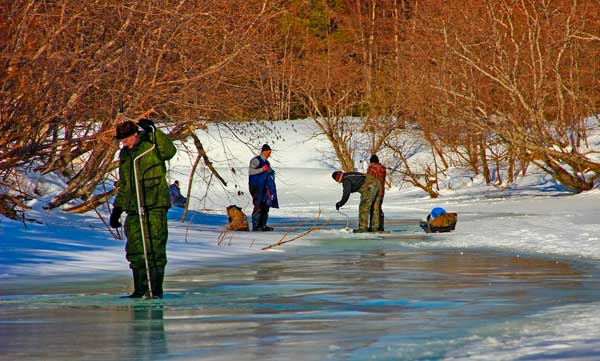
on rewinding and
bait fishing.… The tactic when fishing for perch after the formation of ice is to cover the fished area as wide as possible. 10-15 holes are drilled at a distance of 8-12 meters from each other, so as to cover the entire depth range in a given area.
The wolf’s legs are fed, and the fisherman is fed by the drill. On the first ice, you often have to drill more than a dozen holes. Therefore, a reliable drill with sharp knives is a must. Each hole increases the chance of success, especially in large new areas.
We start fishing with the use of balancers that seduce the most active perch from the maximum distance. When a flock is found after catching aggressive individuals, you can switch to vertical and then bottom baits and more heap drilling of holes, drilling the entire promising area at a distance of 5-7 meters from the hole.
It should be borne in mind that the perch in the first month of freeze-up moves not only horizontally, but also vertically. Therefore, vertical lures are also relevant for fishing, with which the entire water column breaks through up to 1-3 meters from the bottom.
If the spoons and balancers are silent, but there is a feeling that there is still a perch in the hole, we switch to fishing with a
bald , a
devil or other
rewinder , while it is worth reducing the distance between the holes to 2-5 meters, in view of the fact that, with all the catchiness, these baits even less noticeable than spinners and even more balancers. This should be taken into account in a tactical approach to fishing for the First Ice Striped Outlaw.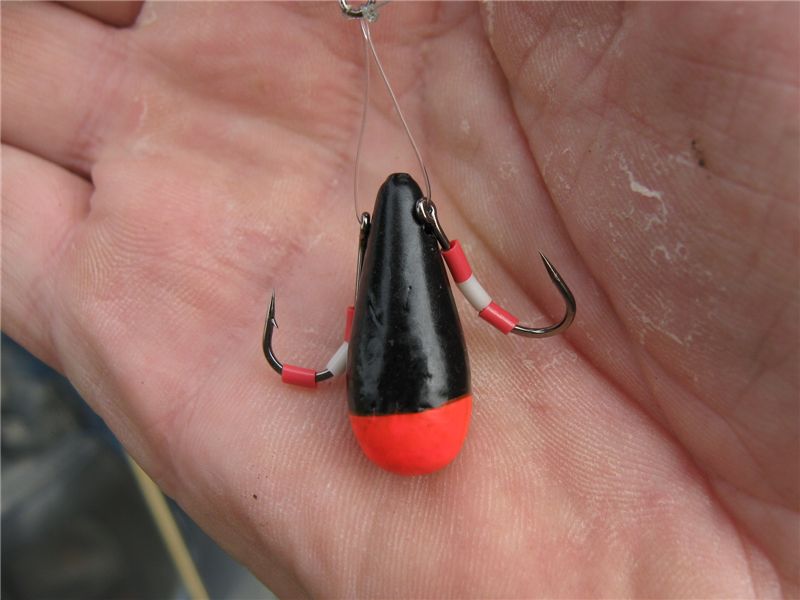
Thus, we will decide on drilling holes. When fishing with a balancer, we do not drill the selected penny far and wide – we just scare the fish away. Not less than 10 meters from each other, in large areas – up to 15-20 meters. If a flock is found, you can try to drill holes around the worker, if she has stopped talking and fish out the place with spoons, rewinders and jigs with a boost.
On the first ice, perch prefers massive lures with active aggressive play. These include spinners (bottom and vertical) and balancer.
Even before the deafness
It should be understood that even before the onset of deafness, after about 2-3 weeks (depending on the size of the water area), the perch gradually rolls down to deeper places, but still showing activity. These are coastal and channel edges, places near fallen trees and bushes, and islets of vegetation. The angler must follow the predator if he hopes to fish successfully. In the first days of freeze-up and 2-3 weeks after it, the perch moves on a large scale. And in such a case, it is very useful to study the reservoir in one way or another. The winter road catches well, which, in the summertime, made a depth map, outlined promising points and, in general, understands what the underwater part of the reservoir looks like, at least approximately.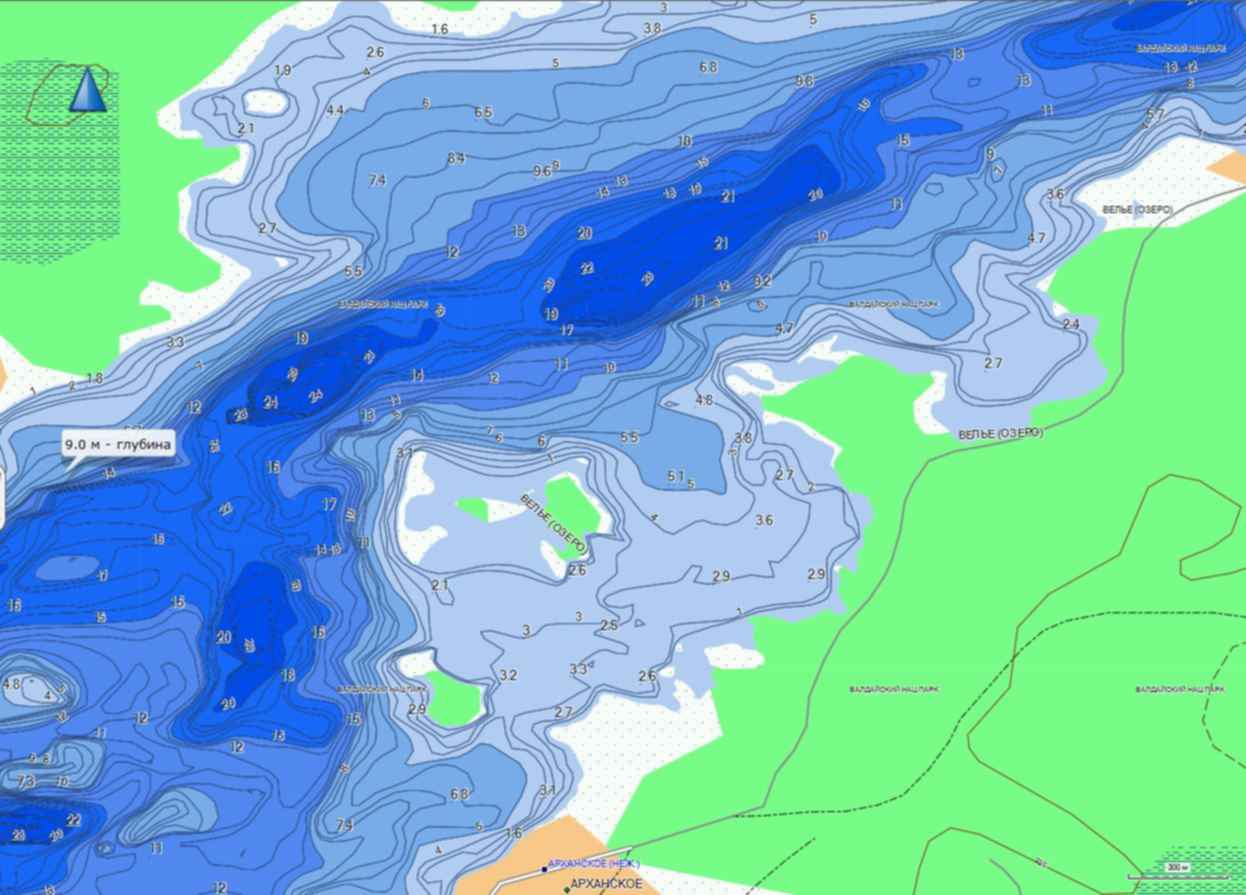
Advice! Depth maps of large bodies of water can be found on specialized services.
Such a map (even in the head, although on paper it is more reliable) will help you quickly explore the reservoir throughout the depths and find out which sites the striped predator prefers at the moment. It is useful to talk to local fishermen, they can often provide valuable information.
What to do if the reservoir is large – the tactics of catching large perch in wide waters
In large waters, when fishing for perch, you have to walk more than one kilometer to attack the flock. We begin to drill holes along the first ice from the coast and gradually go to the channel (at an angle, or perpendicular to the coast – it depends on the conditions), paying special attention to pits and pits, underwater elevations, vegetation and snags, the coastal dump and the channel edge. The distance is up to 20 meters between the holes, if there is a balancer on the line, up to 7-10, if the spoon is spinning, and up to 5, if the jig is without a reel. The holes should be drilled in a checkerboard pattern to quickly close the required area. We drill the holes in batches so that the first hole has time to rest from the noise, by the time the last one is ready.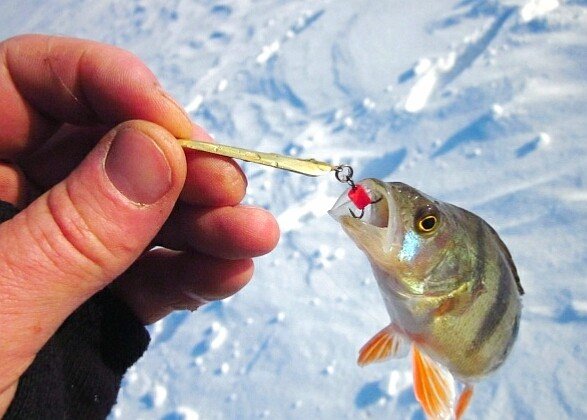
Deafness – a period of passivity
To catch passive perch tolerably in the wilderness, you need to know the places of its stay during this period, as well as understand how to stir up a somnambulistic predator. At such a time, the predator rolls down to the deepest places of the reservoir – pits and areas near them, channel and coastal edges, deep-water plateaus. During such a period, fishing in the shallows and near the coast is a pointless waste of time and effort, unless you like mowing weed grass. Statistically, in the wilderness, the perch not only bites worse, but nevertheless fly in especially much smaller than at the beginning / end of winter, when the medium and large muzzles are much more active and agreeable.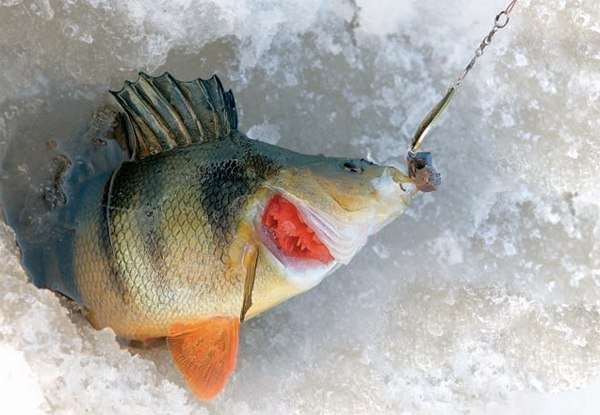
Animation of rewinder and noodles in the middle of winter – the smoothest animation is applied without sudden movements with a lot of pauses and slowdowns. The separation from the bottom is at least 7-10 centimeters, then we tap the bottom several times, pause and repeat all the steps.
Bottom lures animationin the dead of winter, it assumes that the bait is at an angle at the bottom, and does not hover over it, or falls completely flat. It is in this position, at 30-60 degrees to the bottom, that the lure is most attractive for the minke. The separation from the bottom is minimal, no more than 3-5 centimeters. Smooth, with pauses at the end point. You can track this position of the bait at the bottom, as well as play in almost one place, using a nod bent upward without load. Under the weight of the spoon, it bends to the bottom in normal working condition, and when the spoon touches the bottom, the nod begins to unbend upward (detailed video is not the topic below).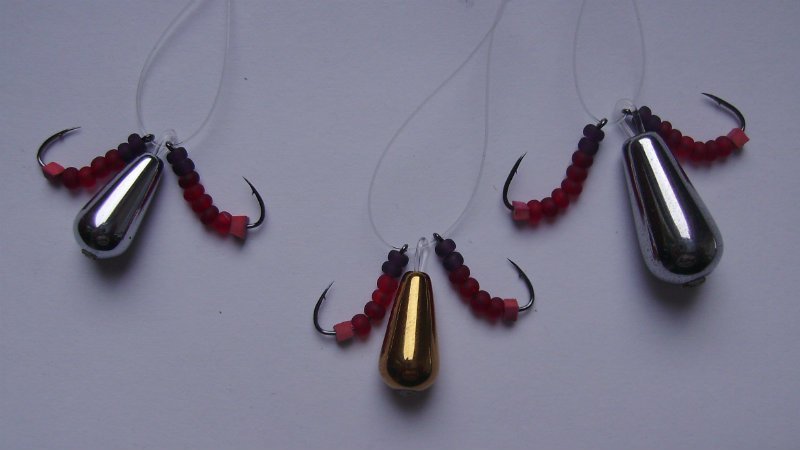
Correctly simple, but valuable – we use lures with passive play in the deep winter, and we perform the animation itself NON-aggressively with smooth and short jerks and pauses at the end points. The separation from the bottom is minimal. We do not leave the hole quickly, unlike the first ice, in the wilderness it is worth giving time to the fish to come up to the bait game. This is especially true when using passive or semi-passive bolds, jigs, bottom baits.
In the most difficult situations, when the perch is silent and does not react, it needs to be stirred up and teased. For this, a series of sweeping jerks with a lure in a range of up to a meter are used. And then a series of frequent and low-amplitude knocks on the back. This patchy play often induces grasping.
On a pond in late winter – early spring
On the last ice, the perch reactivates. This is due to the fact that thawed waters saturate the reservoir with oxygen, which leads to an increase in the activity of small things, and after it a predator. But unlike the first ice, the periods of activity are shorter and vary greatly from reservoir to reservoir. At the end of the freeze-up, the first gullies and fry appear, and after it the predator moves to such zones of the reservoir in search of a source of oxygen and additional food.
If the ice lingered until the end of March, then the activity of the perch increases even more, due to the fact that the predator begins to eat before spawning.
In spring, perch prefers smaller baits than in the first ice, but with a more active game than in the middle of a dead winter. For example, small sizes of spoons, balancers, medium and large rewinder. The animation is also more daring and ragged and stretched across the horizon. Since on the last ice the perch can stand in any layer of water and move during the day, in contrast to the first ice and deafness, when the striped one squeezes to the bottom in most cases. In spring, perch can often be successfully caught half-water and even almost at the edge of the ice. This is worth considering. Having found the horizon in which the minke whale stands, in the future you can reduce the overhang of the line to the required one and not waste time fishing for deeper horizons of water. Regardless of the period, the perch always follows the food base – the trifles of roach, sleeper, bleak and other fish. Where is the little thingthere is a predator. Therefore, having seen or caught such a fish, it is worthwhile to linger on the hole and try to fish it with spoons, balancers and rewinding wheels. Fishing for large perch in winter – video from an expert: https://youtu.be/JQUDB82DukI
What can you catch perch in in winter – popular fishing methods and winter lures
Let’s walk through the methods of fishing for perch in winter in more detail with video tips and practice from experts.
Fishing for perch with balance weights
When fishing for actively feeding perch, balancers are especially good, in view of their main feature – they collect a predator from a large water area, thanks to a characteristic game that resembles a wounded fry, rushing around. The
Balancer is a bait for catching active perch in winter. Perch is especially active on the first ice and at the end of freeze-up, at the same time it moves a lot in the reservoir. This means that you need a bait that seduces a predator from the most distant territory. But, it is worth considering an important nuance, when fishing for perch on the last ice, the minimum sizes of the balancers are used.
Balance weights Rapala, Lucky John, Kuusamo are good perch. Numbers 5,6 are the most versatile for fish weighing 100+ grams throughout the winter, number 3-4 for passive perch, 7 for the muzzle. For poor visibility (cloudy water, early morning / late evening), challenging colors are preferable, for clear water and clear daytime weather, natural colors should be preferred. Fishing for large winter bass with a balancer: https://youtu.be/AqNh42nz49o
Flashing
Fishing for perch in winter also involves the use of vertical lures for fishing in a plumb line. Spoons, unlike balancers, are preferable to use on points / holes where perch parking has already been identified. They work vertically and with less lateral spread than balancers. Fishing for winter perch with bottom lures: https://youtu.be/LQlDJQrivEw Also, lures work on both active and passive perch, when in the wilderness, it is often easier to stir up a lazy pecking minke whale using small spoons with slow types of animation. Also, lures catch winter perch and on the last ice. Fishing for perch with a spoon in winter – video tips: https://youtu.be/8bJLIwAaxUY It is better to use lures among vegetation and small snags. Due to the fact that they do not go too far to the sides during stretching, which means that the chance of a hook is less,than when fishing with a balancer – this is the main disadvantage of balancers. Preference should be given to high-quality home-made or purchased baubles with a welded hook. They have more stable play, cling less and collect trash.
Purchased spinners need to be adjusted, as well as homemade ones. So that they stably roll over from side to side during a vertical fall, while having a well-defined repetitive trajectory.

Be prepared to bite the perch the moment the spinner lands on the bottom.
One of the options to catch a perch of any size is to use powerful large baits, up to 10-12 grams. The peculiarity is that such spoons knock hard on the bottom and collect perch from a long distance. And the minke is not that predator, which is frightened by the size and very willingly bites on such baits.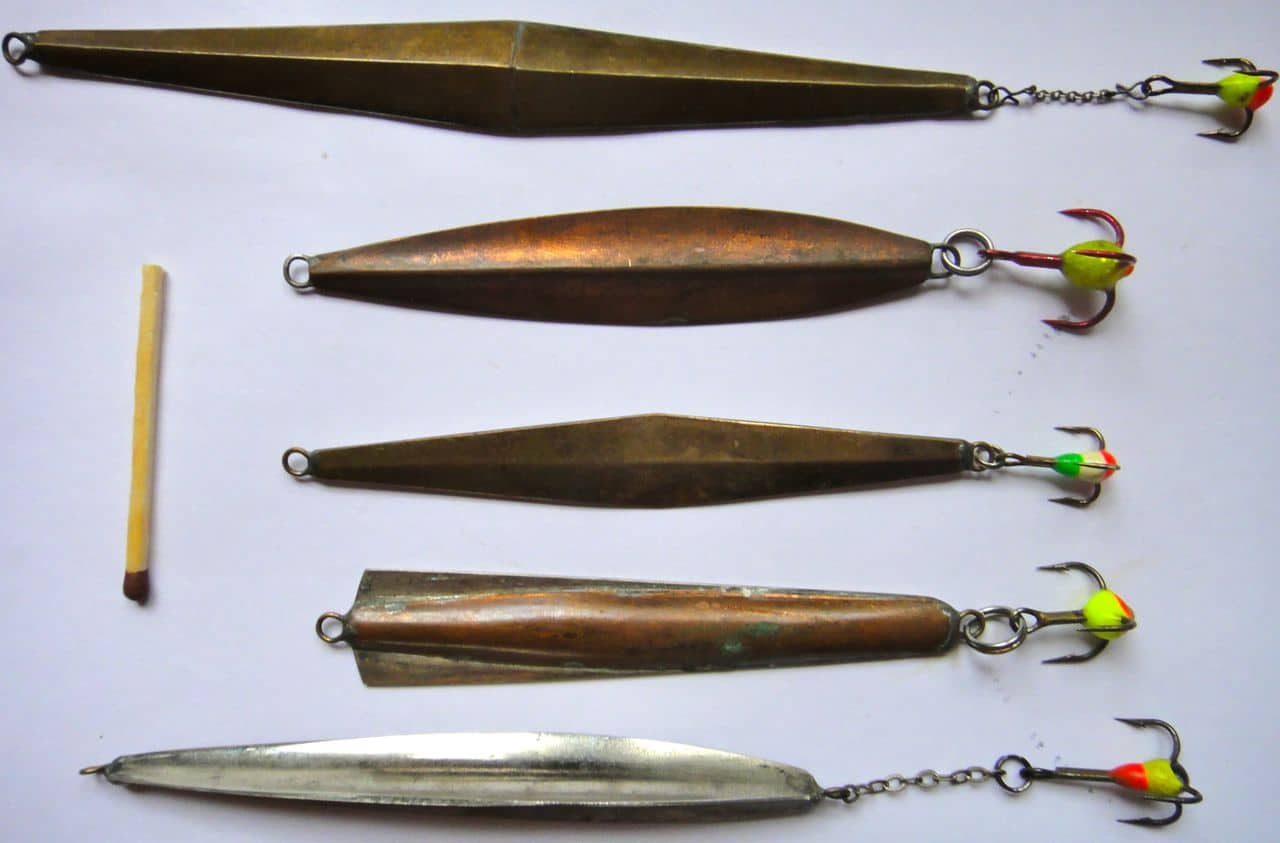
Catching on reels: devil, jellyfish, goat, bulldozer and others
This type of bait is used for catching perch during the entire freeze-up period. Often in the wilderness, rewinderless ones give better results than active spinners and even more balancers. Particularly good are the types of bezels, which have a strictly vertical game and with which you can effectively knock out the dregs at the bottom of the reservoir – devils, goats, bulldozer. Details on how to catch perch on a
rewinder ,
devil ,
bald .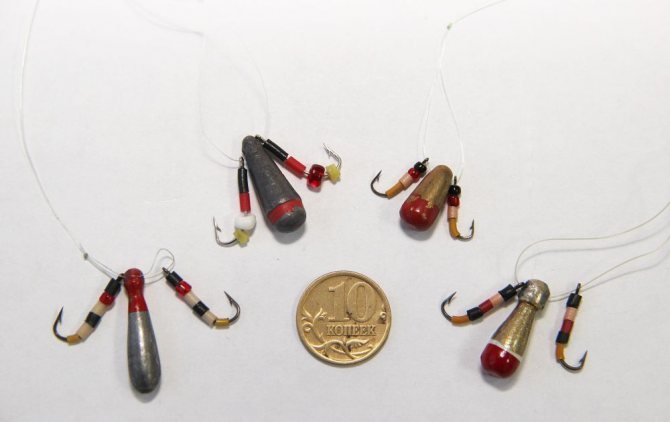
It is interesting and important to know that in muddy water, as well as early in the morning and in the evening at dusk, you should prefer more noticeable baits – spoons, balancers, large sizes of mormyshless jigs. During the day, in clear water, less defiant baits are preferred, which are not so alarming to the predator – small spoon baits, small rewinder and bolds. In very clear water on a clear day, there is no alternative to black with splashes of yellow.
Fishing for large perch in winter – important to know
Large perch, unlike smaller counterparts, is a very careful fish. And in order to catch him, especially in the wilderness, you need not only to know his habits, but also to observe maximum caution and silence. Large humpback-muzzles are afraid of noise! Therefore, promising points where humpbacks can stand must be drilled as quietly and loyally as possible. Here, the tactic of drilling 10-15 holes at the same time is not the best option. We work like this:
- We drill the first hole at the beginning of the fishing trip and move 6-8 meters away.
- We drill a drill into the second hole before reaching the water 1-2 cm (we already know the thickness of the ice and the number of revolutions of the drill required to break through it).
- We return to the first hole and fish for 5-10 minutes, depending on how much the perch sleeps.
- We return to the second hole, we need a turnover of two drills and drill it almost silently.
- We go and do the same steps with the third hole, after which we return to the second hole.
It is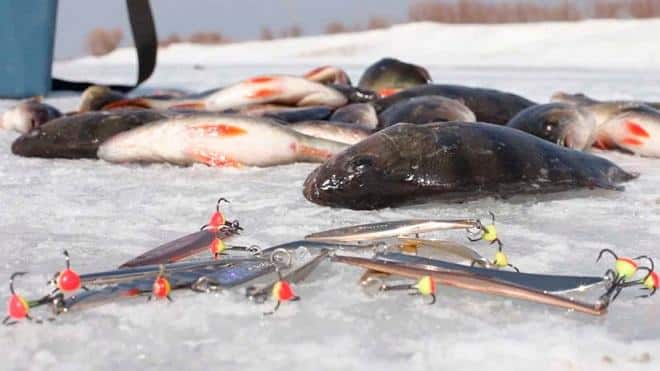
Top dressing
Perch lure should be used only if you plan to spend time on the same holes during the day, or, at least, we will return to them. Most often this happens in the wilderness, when an angler can stay for 10-15 minutes on one hole. As a top dressing, you can use bloodworms, dry blood, baby food, special top dressing.
Be prepared for the fact that instead of perch, a trifle is suitable and fishing may end there if you use small jigs with attachment and rewinding.
Winter tackle for perch – what to look for?
When fishing for perch, a fishing rod is selected based on the prevailing baits. For a spoon and balancer, this is an ordinary Soviet-type fishing rod, rather long with a flexible responsive nod from a spring from a watch or other modern materials. When fishing with reels, the fishing rod should be more delicate and be one piece with other components of the tackle (whip, nod, reel). In particular, they are often used when fishing with jigs, balalaika rods.